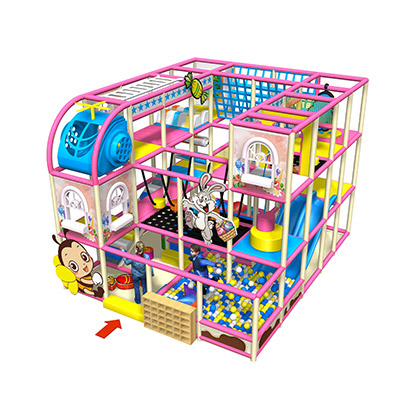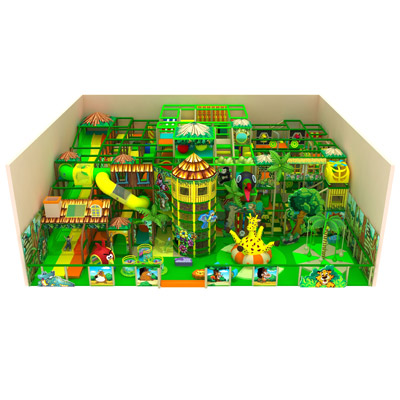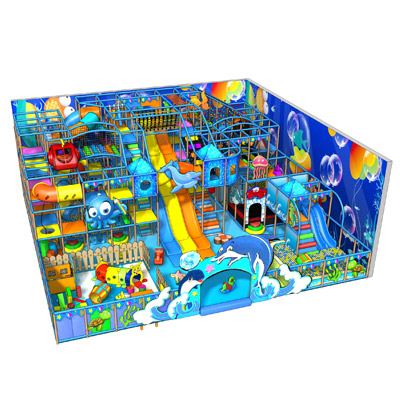How to Create a Safe Indoor Playground
1.Introduction:
Indoor playgrounds offer a safe and fun way for children to play, explore their imagination, and socialize with other kids. They are becoming increasingly popular as families look for ways to keep their kids entertained while being able to ensure everyone's safety. But it’s essential that the design of these safe indoor playground systems is not only used by children but also meets proper safety standards so that no one is harmed in the process – this means considering installation space, any potential risks surrounding the use of equipment, and more than just monitoring what goes on inside an indoor playground by staff or other supervision personnel. In this blog post, we will discuss some key steps to create a safe environment when establishing your indoor playground.

2.Safe Planning
When embarking on the journey of crafting a safe indoor playground, it all begins with a clear vision. Take the time to map out the layout and design, keeping several crucial factors in mind.
(1)Age-Appropriate Zones
Consider the age groups you intend to cater to. Different age ranges have varying needs and abilities, so it's essential to create zones that address these differences. For instance, toddlers require soft play areas with low platforms, while older kids may enjoy more challenging structures.
(2)Adhering to Safety Regulations
A safe indoor playground must not only align with your vision but also meet and exceed local safety regulations and guidelines. To achieve this:
①Know the Regulations
Start by familiarizing yourself with the specific safety regulations and guidelines that apply to indoor play areas in your region. These rules, which are put in place to safeguard children's welfare, must always be followed.
②Design Compliance
Ensure that your design not only meets but exceeds these safety standards. This can include safety features like rounded edges, comfortable padding, and non-toxic materials. By going the extra mile, you'll create an environment where parents and guardians feel confident entrusting their children's safety to your playground.
Remember that a well-thought-out design that adheres to safety regulations forms the solid foundation upon which you can build a truly secure and enjoyable indoor playground for all.

3.Designing a Safe Indoor Playground
(1)Selecting the Right Location
Choosing the appropriate location for your indoor playground is a pivotal decision in ensuring its safety and success. Here's what you need to consider:
①Site Selection Criteria
Begin by establishing specific criteria for your site selection. Factors to assess include the proximity to your target audience, accessibility, parking facilities, and overall convenience for visitors and their guardians.

②Safety Considerations
Prioritize safety when evaluating potential locations. Ensure the site complies with local safety regulations and zoning requirements for indoor play areas. Verify that the chosen location allows for the installation of safety features, such as emergency exits, fire extinguishers, and first-aid stations.
③Accessibility and Inclusivity
Pick a place that is accessible to everyone. Children with a range of physical abilities should feel at home and welcomed in the safe indoor playground.
(2)Layout and Equipment Placement
The layout of your safe indoor playground should encourage safe and supervised play. Here's how to achieve that:
①Clear Visibility
Design the layout in a way that ensures clear lines of sight for supervisors. This visibility allows adults to monitor the children easily, reducing the risk of accidents and ensuring a safe play environment.
②Equipment Spacing
Space out play equipment thoughtfully. Avoid overcrowding, which can lead to collisions and falls. Proper spacing not only enhances safety but also prevents overcrowding-related disputes among young visitors.

(3)Materials and Surfaces for Impact Absorption
①Impact-Absorbing Surfaces
Select materials that provide adequate impact absorption. Flooring materials like rubber, foam, or specialized playground surfacing can reduce the severity of injuries in case of falls. Ensure these materials are correctly installed to avoid tripping hazards.
②Non-Toxic Materials
All materials used in the construction of play equipment should be non-toxic and free from harmful chemicals. Children often explore with their mouths, so ensuring the safety of materials is crucial.
(4)Adequate Lighting and Visibility
①Ample Lighting
Maintain adequate lighting throughout the indoor playground, including all play areas and walkways. Proper illumination reduces the risk of accidents, helps supervisors monitor activities, and creates a welcoming atmosphere.
②Visibility Enhancements
Consider adding features that enhance visibility, such as mirrors strategically placed to eliminate blind spots. Additionally, there may be an abundance of natural light provided by windows or open design.
In summary, designing a safe indoor playground requires meticulous planning and a strong focus on safety at every stage. Prioritizing visibility, proper spacing and safe materials ensures that your indoor playground is an enjoyable and secure space for children to explore and play.

4.Equipment Selection and Maintenance
(1)Types of Amusement Equipment to Consider
①Age-Appropriate Equipment
Ensure that the equipment you choose is suitable for the age groups your indoor playground intends to serve. Age-appropriate apparatus reduces the likelihood of mishaps and injuries. Safe indoor playgrounds for Toddlers, for example, can opt for softer, simpler play. Examples include Soft Play Areas, Small Slides, Gentle Swings, and more. More information about Age-appropriate equipment can refer to:
https://www.dreamlandplayground.com/blog/what-is-the-age-group-for-inside-playground-equipment
②Durability and Safety Features
Prioritize equipment made from durable materials that can withstand regular use. A robust handrail, rounded edges, and non-slip surfaces are all good safety elements to look for.
(2)Regular Inspection and Maintenance
①Inspection Schedule
Establish a routine inspection schedule for all play equipment. Inspections regularly aid in finding symptoms of damage, loose parts, or wear and tear.

②Timely Repairs
prompt repairs Address any problems found during inspections right away. To avoid accidents, fix or replace defective equipment. Maintain maintenance and repair logs for future reference.
③Cleaning and Sanitization
Sanitation and Cleaning By routinely cleaning and sanitizing the equipment, you can maintain a clean and sanitary atmosphere. Cleanliness promotes a healthy play environment and stops the transmission of germs.
(3)Compliance with Safety Standards
Verify that all equipment complies with and/or exceeds safety requirements. Purchase equipment from reputable manufacturers with a track record of compliance with safety standards. Look for certifications such as ASTM International and European Union CE markings.
By carefully selecting equipment, implementing a rigorous maintenance schedule, and ensuring compliance with safety standards, you can create a safe indoor playground where children can play and explore with confidence, knowing their safety is a top priority.

5.Safety Signs and Guidelines
(1)Posted Rules and Guidelines
In an indoor playground, having clear rules and guidelines is crucial for maintaining safety. Here are some key aspects to consider:
①Visible Signs
Ensure that safety signs are prominently displayed throughout the indoor playground. These signs should be clear and easy to understand, serving as reminders for visitors to follow the rules.
②Entrance Prompts
Place informative signs at entrances, listing the rules of the indoor playground, including regulations applicable to different age groups and any special safety requirements. Establish visitor guidelines that specify safety behavior standards, such as no running, no climbing in non-designated areas, and more.

(2)The Importance of Supervision and Staff Training
Supervision and staff training in the indoor playground are essential for ensuring safety:
Establish an effective supervision system to ensure an adequate number of staff members are present to promptly address potential safety issues. Supervisors ought to receive emergency response training.
All staff members should undergo safety training, including training on how to handle emergencies. Staff should know how to assist visitors and engage with them positively to ensure rule enforcement.
Conduct regular simulated emergency drills to ensure that staff members are familiar with response procedures and can take swift action when needed.
(3)Parental Responsibility and Involvement
Parents play a significant role in maintaining safety. Parents should understand and actively participate in supervising their children. They should educate their children about following rules and avoiding risky behaviors. Parents can actively engage by accompanying their children during activities in the indoor playground. This helps enhance children's awareness of safety and ensures they are cared for while playing.
If parents identify safety concerns or have other worries, they should contact indoor playground management, offer support, and provide feedback to help improve safety standards.
Through clear safety signs and guidelines, staff training, and active parental involvement, a safe environment within the indoor playground can be collectively maintained. This allows children to enjoy a fun and secure playing experience.
6.Emergency Preparedness: Ensuring Safety at Your Safe Indoor Playground
(1)First Aid and Medical Supplies
One of the cornerstones of emergency preparedness is having a well-equipped first aid station. Your indoor playground should be stocked with essential medical supplies, including bandages, antiseptics, gauze, and scissors. In addition to these basics, consider specific items like ice packs for minor bumps and bruises, disposable gloves for hygienic assistance, and an automated external defibrillator (AED) for severe emergencies. Check the expiration dates of these goods often and replace them as necessary.

(2)Evacuation Procedures
A clear evacuation strategy can save lives in the case of a fire, a natural disaster, or any other unanticipated circumstances. well-defined evacuation plan can be a lifesaver. Collaborate with your local fire department or emergency services to establish clear evacuation routes and procedures. Post evacuation maps throughout your indoor playground, making them easily visible to both staff and visitors. Conduct regular drills to ensure that everyone, including your staff, knows what to do in an emergency. Designate assembly points outside the building to account for all individuals and facilitate efficient communication with emergency services.
(3)Staff Training in Handling Emergencies
The first line of defense in any emergency is your personnel. To guarantee a secure experience on an indoor playground, their training may make a huge impact. Invest in thorough training programs that address a variety of emergency, from minor injuries to evacuations.
Ensure that your staff is proficient in administering basic first aid and CPR. tips on using emergency tools like fire extinguishers and AEDs as well as good communication during emergencies.
By prioritizing emergency preparedness and showcasing your commitment to safety, you not only create a secure environment for your visitors but also enhance your credibility as a safe indoor playground operator.
7.Conclusion
Creating a safe indoor playground is not an easy task, but with the right planning, design, selection, and maintenance of equipment, safety signs to guide your visitors, and emergency preparedness you can create a top-tier safe environment for play. Most importantly, such a space needs to have the necessary help that can meet its demands. Now that you are equipped with this knowledge, make sure to assess your indoor playground plan regularly to maintain and further ensure the safety of those who use it.

If you need professional consulting services or assistance when creating a safe indoor playground for your facility contact us today so we can answer any questions or concerns you may have. At Dreamland Playground, we understand the importance of safety in indoor play spaces and offer expert guidance and equipment to create the safest environment possible. We encourage customers not only to focus on their investments in terms of profit but also on how that investment will be impactful in terms of health and safety among all users. Our team is dedicated to helping you ensure that your safe indoor playground meets all necessary criteria so that everyone in attendance can feel comfortable and enjoy their time at your facilities. To find out more about how we can assist you in creating a top-notch, secure indoor playground, contact us right now.











